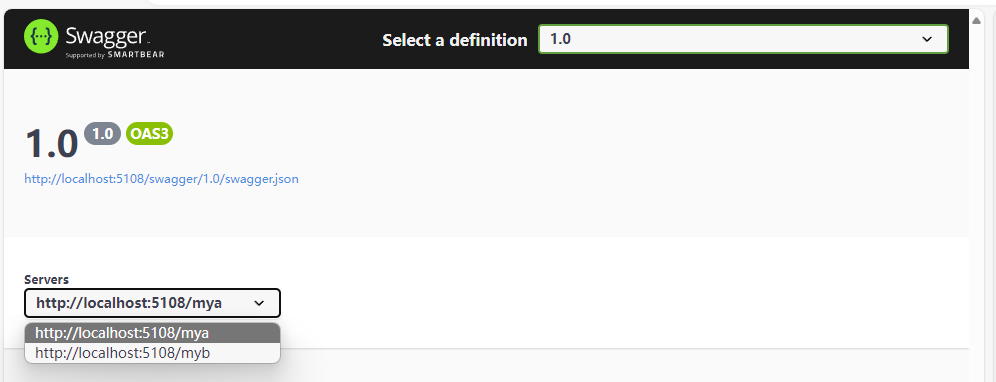ASP.NET Core 定制
Web 开发是 .NET 最广泛使用的场景之一,现在越来越多的企业 Web 开发业务系统采用 ASP.NET Core 或第三方框架如 ABP 等进行开发,这些第三方框架绝大多数是基于 ASP.NET Core 进行开发的,当然每个企业或每个开发者对框架的需求都不一样,有的人觉得 ABP 满足了大多数需求,有的人觉得 ABP 太重了,也有很多人选择自己基于 ASP.NET Core 开发新的 Web 开发框架。由于 ASP.NET Core 是 .NET 日常开发中最常是使用的框架,因此本章主要讲解如何定制 Web,以便满足不同的需求。
创建 Maomi.Web.Core 项目,添加对 Maomi.Core 的引用,接着创建模块类 MaomiWebModule.cs。
public class MaomiWebModule : IModule
{
public void ConfigureServices(ServiceContext context)
{
}
}
定制统一响应模型
无论是报错还是模型验证失败、请求成功等,都要设置一定的响应体格式,方便前端或客户端使用。
在编程中,常见 return 缩写为 ret,result 缩写为 res,不过在 C# 中并不提倡缩写,不过考虑到响应模型类使用太频繁,为了便于使用,可以将响应模型类设置为 Res。
// 响应模型类
public class Res<T>
{
// 当前请求是否有错误
public virtual bool IsSuccess => Code == 200;
// 业务代码
public virtual int Code { get; set; }
// 响应消息
public virtual string Msg { get; set; }
// 返回数据
public virtual T? Data { get; set; }
}
// 响应模型类
public partial class Res : Res<object?>
{
// 创建 Res
public static Res<T> Create<T>(int code, string message, T data)
{
return new Res<T>
{
Code = code,
Msg = message,
Data = data
};
}
/// 创建 Res
/// </summary>
public static Res<T> Create<T>(HttpStatusCode code, string message, T data) => Create((int)code, message, data);
}
// 分页结果模型类
public class PageRes<T>
{
/// 当前页
public virtual int PageNo { get; set; }
/// 页大小
public virtual int PageSize { get; set; }
public virtual T? List { get; set; }
}
// 分页结果模型类
public partial class PageListRes<T> : Res<PageRes<IEnumerable<T>>>
{
}
/// 分页结果模型类
/// <typeparam name="T"></typeparam>
public partial class PageArrayRes<T> : Res<PageRes<T[]>>
{
}
模型验证
在本节中,我们将来学习如何在控制台使用模型验证以及 ASP.NET Core 中的模型验证是怎么实现的。
标记的特性注解称为 DataAnnotations 数据注释。在使用 ASP.NET Core 时,我们可以通过对模型类设置 [EmailAddress]、[Required] 等特性注解,用户的数据请求便会被 ASP.NET Core 拦截并验证其模型是否正确。
模型验证是如何实现的
实际上,模型验证也可以脱离 ASP.NET Core 使用,我们可以新建控制台。
示例项目在 Demo10.ConsoleDataAnnotations 中。
首先定义一个模型类:
public class UserInfo
{
[Required]
[EmailAddress]
public string Email { get; set; }
}
然后创建一个验证器方法:
private static (bool IsValid, IReadOnlyList<ValidationResult> ValidationResult) VerifyModel(object o)
{
var result = new List<ValidationResult>();
var validationContext = new ValidationContext(o);
var isValid = Validator.TryValidateObject(o, validationContext, result, validateAllProperties: true);
return (isValid, result);
}
ValidationContext:模型验证检查上下文。
Validator.TryValidateObject:使用验证上下文和验证结果集合确定指定对象是否有效。
然后,使用它:
static void Main()
{
var json = """
{
"Email":"aaa#qq.com"
}
""";
var userInfo = System.Text.Json.JsonSerializer.Deserialize<UserInfo>(json);
var (isValid, result) = VerifyModel(userInfo);
if (!isValid)
{
foreach (var item in result)
{
Console.WriteLine($"{item.MemberNames.First()}:{item.ErrorMessage}");
}
}
}
这段代码运行之后,会输出:
Email:The Email field is not a valid e-mail address.
其实可以看到,模型验证最核心的是使用 ValidationContext 和 Validator.TryValidateObject 对模型的属性字段进行检查,然后获取检查结果。
ASP.NET Core 本质也是控制台,API 接口的模型类进行模型验证时的机制也差不多如此,例如当用户发起一个 application/json 请求时,首先从 Body 中取出 json 反序列化为对象,此过程可以配置是否忽略大小写、字符串和枚举或数字互转等,在反序列化时,如果有报错,则会抛出异常。接着会对模型类进行验证,如果验证失败,则会返回 400 状态码。
下面是一些内置的验证属性:
[ValidateNever]:不验证此属性。[CreditCard]:是否为信用卡格式。[Compare]: 对比模型中两个字段值是否一致。[EmailAddress]:属性为电子邮件格式 。[Phone]:属性为电话号码格式。[Range]:属性在值范围之内。[RegularExpression]:使用正则表达式验证属性。[Required]:该属性必填。[StringLength]:限制字符串的最大长度。[Url]:属性为 url 地址格式。
所有的模型验证类都继承了 ValidationAttribute,所以也可以直接通过模型验证类的 IsValid 方法获取验证结果。
示例:
bool isValid = new EmailAddressAttribute().IsValid(userInfo);
自定义模型验证器
处理 .NET 自带的模型验证特性外,我们也可以自定义特性类。在本小节中,笔者将会介绍如何实现一个模型验证特性。
示例项目在 Demo10.ConsoleDataAnnotations 中。
假设的场景如下,我们需要在邮件地址字段中,检查邮件后缀是否为 @maomi.com。
自定义模型验证器主要是重写两个 IsValid,示例代码如下:
public class MaomiEmailAttribute : ValidationAttribute
{
public override bool IsValid(object? value)
{
if (value is string email)
{
return email.EndsWith("@maomi.com");
}
return false;
}
protected override ValidationResult? IsValid(object? value, ValidationContext validationContext)
{
// 成员名称
var memberName = validationContext.MemberName;
// [DisplayName] 定义的名称
var displayName = validationContext.DisplayName;
// 实例对象
var obj = validationContext.ObjectInstance;
if (this.IsValid(value))
{
return ValidationResult.Success;
}
string[] memberNames = memberName != null ? new string[] { memberName } : null;
return new ValidationResult(this.FormatErrorMessage(validationContext.DisplayName), memberNames);
}
public override string FormatErrorMessage(string name)
{
return $"{name} 不是 @maomi.com 邮箱后缀!";
}
}
然后新建 UserInfoMaomi 模型类:
public class UserInfoMaomi
{
[Required]
[EmailAddress]
[MaomiEmail]
public string Email { get; set; }
}
将 json 字符串改成:
var json = """
{
"Email":"aaa@qq.com"
}
""";
var userInfoMaomi = System.Text.Json.JsonSerializer.Deserialize<UserInfoMaomi>(json);
var (isValid2, result2) = VerifyModel(userInfoMaomi);
由于我们使用 VerifyModel 方法,验证模型使用的是 Validator.TryValidateObject,因此调用模型验证特性类,会使用 IsValid(object?, ValidationContext) 重载。
而 IsValid(object? value) 重载,我们可以单独针对一个值来使用:
new MaomiEmailAttribute().IsValid("aaa@qq.com")
模型验证器使用 i18n
ASP.NET Core 中模型验证器打印的字符串默认都是英文,我们在业务中往往需要多语言以及自定义模型验证特性,因此有必要让模型验证也支持 i18n。
在 Maomi.Web.Core 中添加 Maomi.I18n 引用。
我们在 Maomi.I18n 中添加一个扩展类型,用来为 API 注入 I18n 扩展服务。
public static class DataAnnotationsExtensions
{
// 为 API 模型验证注入 i18n 服务
public static IMvcBuilder AddI18nDataAnnotation(this IMvcBuilder builder)
{
builder.Services.AddTransient<IStringLocalizerFactory, I18nStringLocalizerFactory>();
builder
.AddDataAnnotationsLocalization(options =>
{
options.DataAnnotationLocalizerProvider = (modelType, stringLocalizerFactory) =>
stringLocalizerFactory.Create(modelType);
});
return builder;
}
}
注入模型验证本地化服务之后,框架会从此模型类所在的程序集中取出本地化语言字符串。
在 MaomiWebModule 中添加 i18n 服务,以及为 API 注入模型验证服务。
public class MaomiWebModule : IModule
{
public void ConfigureServices(ServiceContext context)
{
// i18n 服务
context.Services.AddI18n("zh-CN");
context.Services.AddI18nResource(options =>
{
options.AddJson<MaomiWebModule>("i18n");
});
// 添加控制器
context.Services.AddControllers()
.AddI18nDataAnnotation();
}
}
然后创建名为 Demo10.ApiDataAnnotations 的 API 服务,添加对 Maomi.Web.Core 的引用,项目结构如下。
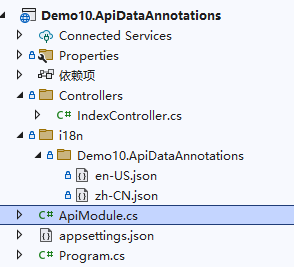
我们将 Demo10.ApiDataAnnotations 模块化后,只需要在该项目中注入 json 多语言资源服务即可。
[InjectModule<MaomiWebModule>()]
public class ApiModule : IModule
{
public void ConfigureServices(ServiceContext context)
{
context.Services.AddI18nResource(options =>
{
options.AddJson<ApiModule>("i18n");
});
}
}
然后我们在该项目中创建一个模型类:
public class UserInfo
{
[EmailAddress(ErrorMessage = "邮箱地址格式不正确")]
public string Email { get; set; }
}
因为 UserInfo 模型类在 Demo10.ApiDataAnnotations 项目中,因此我们需要在 Demo10.ApiDataAnnotations 中创建 json 多语言资源文件,目录在 i18n/Demo10.ApiDataAnnotations 下。
json 文件示例如下:
zh-CN.json
{
"邮箱地址格式不正确": "邮箱地址格式不正确"
}
en-US.json
{
"邮箱地址格式不正确": "The email address format is incorrect"
}
然后创建一个简单的 API 接口进行测试:
[ApiController]
[Route("[controller]")]
public class IndexController : ControllerBase
{
[HttpPost("user")]
public string GetUserName([FromBody] UserInfo info)
{
return info.Email.Split("@").FirstOrDefault();
}
}
然后对 API 发出请求,分别在 email 字段输入不同的内容。

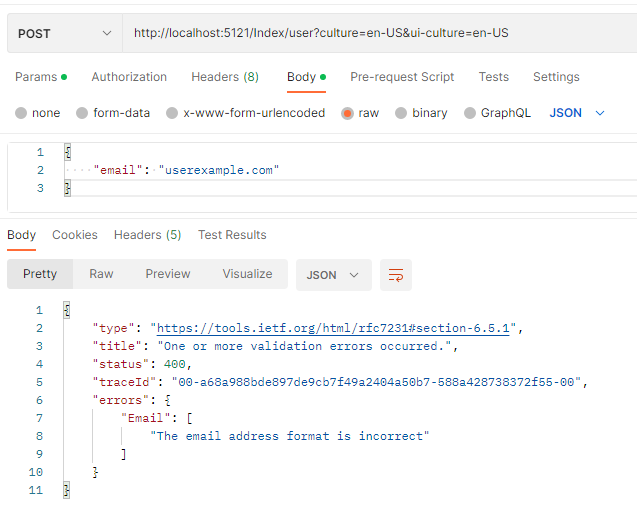
使用 i18n 服务之后,模型验证错误会随着语言标识而变化。
筛选器
我们知道,ASP.NET Core 的功能是由一系列中间件管道提供的,当 API 接收一个 http 请求时,请求上下文会经过管道中各种中间件的处理,最后到达 Action 中。
ASP.NET Core 管道中默认中间件的排序顺序如下图所示:
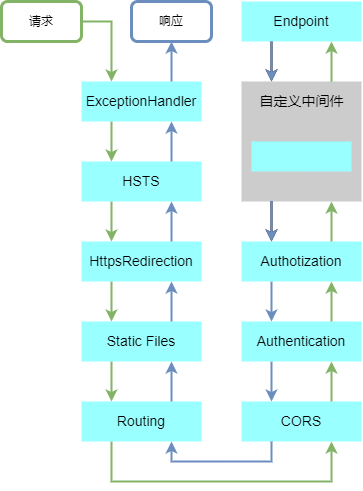
ASP.NET Core 中提供了筛选器,可以帮助我们在部分中间件的前后执行一系列的操作。
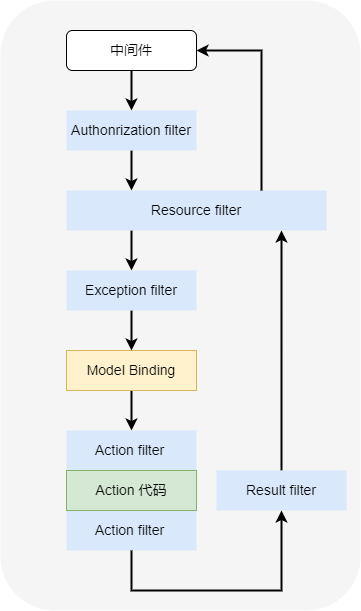
Action 筛选器
在 ASP.NET Core 中,当模型验证失败时,会返回如下格式的内容。
{
"type": "https://tools.ietf.org/html/rfc7231#section-6.5.1",
"title": "One or more validation errors occurred.",
"status": 400,
"traceId": "00-4fcae233f0ff7c4de765680f5ee8b8b8-67b2c0d9a41224c6-00",
"errors": {
"Email": [
"The email address format is incorrect"
]
}
}
但是在项目开发中,我们往往需要固定一种格式,比如本章开头就设置了统一的响应模型类 Res、Res<T>。
在 Maomi.Web.Core 中,依次创建 i18n、Maomi.Web.Core 目录,添加 zh-CN.json、en-US.json 两个文件,内容分别如下:
zh-CN.json
{
"400": "发生了一个或多个验证错误"
}
en-US.json
{
"400": "One or more validation errors occurred."
}
设置两个文件的生成属性为 “始终复制”。

为了通过项目引用、nuget 包引用时,文件会自动复制到启动项目运行目录中,需要手动配置多语言文件属性:
<ItemGroup>
<None Update="i18n\Maomi.Web.Core\en-US.json" Pack="true" PackagePath="contentFiles\any\any;">
<PackageCopyToOutput>true</PackageCopyToOutput>
</None>
</ItemGroup>
<ItemGroup>
<None Update="i18n\Maomi.Web.Core\zh-CN.json" Pack="true" PackagePath="contentFiles\any\any;">
<PackageCopyToOutput>true</PackageCopyToOutput>
</None>
</ItemGroup>
由于 Microsoft.NET.Sdk.Web SDK 在编译 Web 项目时,会自动配置 json 文件属性,这样一来会导致与手动配置的多语言文件属性配置冲突,因此需要关掉该功能。
<EnableDefaultContentItems>false</EnableDefaultContentItems>
Action 筛选器在执行 Action 之前或之后被框架自动调用,用来拦截请求或处理 Action 返回的结果。Action 筛选器有两种实现方法,第一种是实现 IActionFilter 接口,然后依赖注入配置控制器时通过 .AddControllers() 扩展方法配置全局。第二种使用特性注解,单独给 Controller 或 Action 使用。
使用特性注解配置 Action,需要继承 ActionFilterAttribute 特性,简化我们编写筛选器的代码。
ActionFilterAttribute 的定义如下:
[AttributeUsage(AttributeTargets.Class | AttributeTargets.Method, AllowMultiple = true, Inherited = true)]
public abstract class ActionFilterAttribute :
Attribute,
IActionFilter,
IFilterMetadata,
IAsyncActionFilter,
IResultFilter,
IAsyncResultFilter,
IOrderedFilter
{
protected ActionFilterAttribute();
public int Order { get; set; }
public virtual void OnActionExecuted(ActionExecutedContext context);
public virtual void OnActionExecuting(ActionExecutingContext context);
public virtual Task OnActionExecutionAsync(ActionExecutingContext context, ActionExecutionDelegate next);
public virtual void OnResultExecuted(ResultExecutedContext context);
public virtual void OnResultExecuting(ResultExecutingContext context);
public virtual Task OnResultExecutionAsync(ResultExecutingContext context, ResultExecutionDelegate next);
}
在 Maomi.Web.Core 中创建一个名为 MaomiActionFilter 的筛选器,同时继承 ActionFilterAttribute、IActionFilter,MaomiActionFilter 筛选器使用时需要注入相关的依赖。
// Action 过滤器
[InjectOn(Scheme = InjectScheme.None, Own = true)]
[AttributeUsage(AttributeTargets.Class | AttributeTargets.Method, AllowMultiple = false, Inherited = true)]
public class MaomiActionFilter : ActionFilterAttribute
{
private readonly IStringLocalizer<ActionFilter> _localizer;
public ActionFilter(IStringLocalizer<ActionFilter> stringLocalizer)
{
_localizer = stringLocalizer;
}
public override void OnResultExecuting(ResultExecutingContext context)
{
if (!context.ModelState.IsValid)
{
Dictionary<string, List<string>> errors = new();
foreach (var item in context.ModelState)
{
List<string> list = new();
foreach (var error in item.Value.Errors)
{
list.Add(error.ErrorMessage);
}
errors.Add(item.Key, list);
}
context.Result = new BadRequestObjectResult(R.Create(400, _localizer["400"], errors));
}
}
}
MaomiActionFilter 使用了自动注册特性,我们只注册 MaomiActionFilter,而不包含 ActionFilterAttribute、IActionFilter。
然后在 Demo10.ApiDataAnnotations 项目中的 IndexController 中加上 MaomiActionFilter 特性。
[ApiController]
[Route("[controller]")]
public class IndexController : ControllerBase
{
[ServiceFilter(typeof(MaomiActionFilter))]
[HttpPost("user")]
public string GetUserName([FromBody] UserInfo info)
{
return info.Email.Split("@").FirstOrDefault();
}
}
启动 Web 程序,请求该接口,模型验证错误的结果使用固定格式响应。
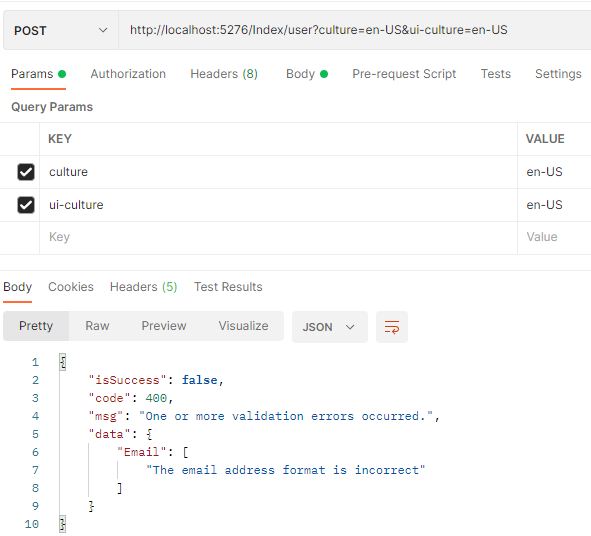
ActionFilterAttribute 可以用在 Action 上,也可以用在 Controller 上,在 Controller 配置时,对所有 Action 起效。
[ServiceFilter(typeof(MaomiActionFilter))]
[ApiController]
[Route("[controller]")]
public class IndexController : ControllerBase
{
}
因为 MaomiActionFilter 需要进行依赖注入,需要使用 ServiceFilter 配置筛选器,如果自定义的 ActionFilterAttribute 并不需要使用依赖注入,那么可以直接使用。
[MyActionFilter]
[HttpPost("user")]
public string GetUserName([FromBody] UserInfo info)
{
return info.Email.Split("@").FirstOrDefault();
}
我们也可以使用全局配置:
context.Services.AddControllers(options =>
{
// 不需要依赖注入的筛选器
// options.Filters.Add<MyActionFilter>();
// 需要依赖注入的筛选器
options.Filters.AddService<MaomiActionFilter>();
})
我们将 Maomi.Web.Core.MaomiWebModule 改造一下。
public class MaomiWebModule : IModule
{
public void ConfigureServices(ServiceContext context)
{
// i18n 服务
context.Services.AddI18n("zh-CN");
context.Services.AddI18nResource(options =>
{
options.AddJson<MaomiWebModule>("i18n");
});
// 添加控制器
context.Services.AddControllers(options =>
{
options.Filters.Add<MaomiActionFilter>();
options.Filters.AddService<MaomiActionFilter>();
})
.AddI18nDataAnnotation();
}
}
现在,Maomi.Web.Core 已经具备了本地化多语言、模型验证信息多语言、统一模型验证输出三个功能了。
资源筛选器
资源筛选器有 IResourceFilter 或 IAsyncResourceFilter 两种接口,接口定义如下:
public interface IResourceFilter : IFilterMetadata
{
void OnResourceExecuted(ResourceExecutedContext context);
void OnResourceExecuting(ResourceExecutingContext context);
}
public interface IAsyncResourceFilter : IFilterMetadata
{
Task OnResourceExecutionAsync(ResourceExecutingContext context, ResourceExecutionDelegate next);
}
资源筛选器发生在模型绑定、Action 之前,因此可以提前做预检查提前拦截非正常请求等。对于某些情况下 API 要求携带 header 或者其他参数时,在资源筛选器处理会比在 API 中处理好,减少了一些过程,节约了资源。
假设有这么一个场景,我们需要将 API 的结果缓存到 Redis 中,当用户请求时,如果 Redis 中有缓存则直接返回,不需要再进入 Controller、Action 中。如果换成不存在,则执行 Action 并返回结果,然后自动加入到 Redis 缓存中。
新建名为 Demo10.ResourceFilter 的 Web项目,并新建 CacheResourceFilter 类型,引入 Maomi.Web.Core、FreeRedis 两个依赖。
新建 CacheResourceFilter 筛选器,CacheResourceFilter 使用 {ControllerName}:{ActionName} 作为 key 名称,从 redis 中获取数据,然后直接写入到响应中,不需要再执行 Action 中代码。
[InjectOn(Scheme = InjectScheme.None, Own = true)]
[AttributeUsage(AttributeTargets.Class | AttributeTargets.Method, AllowMultiple = false, Inherited = true)]
public class CacheResourceFilter : Attribute, IAsyncResourceFilter
{
private readonly IStringLocalizer<CacheResourceFilter> _localizer;
private readonly IRedisClient _redisClient;
public CacheResourceFilter(IStringLocalizer<CacheResourceFilter> stringLocalizer, IRedisClient redisClient)
{
_localizer = stringLocalizer;
_redisClient = redisClient;
}
public async Task OnResourceExecutionAsync(ResourceExecutingContext context, ResourceExecutionDelegate next)
{
var action = context.ActionDescriptor as Microsoft.AspNetCore.Mvc.Controllers.ControllerActionDescriptor;
ArgumentNullException.ThrowIfNull(action);
var key = $"{action.ControllerName}:{action.ActionName}";
var methodInfo = action.MethodInfo;
var returnResult = methodInfo.ReturnType;
if (returnResult.GetGenericTypeDefinition() == typeof(Task<>))
{
returnResult = returnResult.GetGenericArguments()[0];
}
// 如果有缓存
var text = await _redisClient.GetAsync<string>(key);
if (!string.IsNullOrEmpty(text))
{
var value = System.Text.Json.JsonSerializer.Deserialize(text, returnResult);
context.Result = new JsonResult(value);
return;
}
var newContext = await next();
// 记录到缓存中,下次直接从缓存中取出
var result = newContext.Result as ObjectResult;
if (result != null)
{
await _redisClient.SetAsync(key, result.Value, timeoutSeconds: 10);
}
}
}
然后编写一个 API 进行测试:
[ApiController]
[Route("[controller]")]
public class TestController : ControllerBase
{
[HttpGet(Name = "get")]
public IEnumerable<TestModel> Get()
{
var data = new List<TestModel>()
{
new TestModel(){ Name = "1"},
new TestModel(){ Name = "2"}
};
return data;
}
}
public class TestModel
{
public string Name { get; set; }
}
然后配置 API 模块:
[InjectModule<MaomiWebModule>()]
public class ApiModule : IModule
{
public void ConfigureServices(ServiceContext context)
{
context.Services.AddControllers(options =>
{
// 这里不会跟 MaomiWebModule 中的筛选器冲突,两者的筛选器会被合起来一起使用
options.Filters.AddService<CacheResourceFilter>();
});
// 配置 FreeRedis
RedisClient redis = new RedisClient("127.0.0.1:6379,defaultDatabase=0");
redis.Serialize = obj => System.Text.Json.JsonSerializer.Serialize(obj);
redis.Deserialize = (json, type) => System.Text.Json.JsonSerializer.Deserialize(json, type);
context.Services.AddSingleton<IRedisClient, RedisClient>(s => redis);
}
}
你可以在 CacheResourceFilter 中进行断点调试,你会发现在第一次请求之后,会直接在 Redis 中取得数据,而不需要执行 await next()。
为什么笔者不把 CacheResourceFilter 放到 Maomo.Web.Core 中。
因为 ResourceFilter 通用的场景比较少,不必要在模块化框架中混入太多组件,比如上一小节的 ActionFilter 中也仅仅是为了通用返回的模型验证错误的格式。
每个公司可能在过滤器中有不一样的需求,甚至每个项目都有不同的需求,这些很可能在开发中定制需求,那么正在框架之外,编写扩展完善补充即可。
Maomi.Web.Core 框架应当保持简洁,支持基础功能即可。
异常筛选器
异常筛选器主要用于捕获发生在 Action 中的异常。
当 API 出现异常时,我们需要屏蔽异常信息以免泄露敏感信息,以及统一响应模型。
我们在 Maomi.Web.Core 中定义一个异常筛选器 MaomiExceptionFilter,我们需要将异常信息输出到日志中,统一响应结果,并且显示的信息使用 i18n 进行多语言支持。
// 统一异常处理
[InjectOn(Scheme = InjectScheme.None, Own = true)]
public class MaomiExceptionFilter : IAsyncExceptionFilter
{
private readonly ILogger<MaomiExceptionFilter> _logger;
private readonly IStringLocalizer<MaomiExceptionFilter> _stringLocalizer;
// 统一异常处理
public MaomiExceptionFilter(ILogger<MaomiExceptionFilter> logger, IStringLocalizer<MaomiExceptionFilter> stringLocalizer)
{
_logger = logger;
_stringLocalizer = stringLocalizer;
}
/// 异常处理
public async Task OnExceptionAsync(ExceptionContext context)
{
// 未经处理的异常
if (!context.ExceptionHandled)
{
var action = context.ActionDescriptor as Microsoft.AspNetCore.Mvc.Controllers.ControllerActionDescriptor;
_logger.LogCritical(context.Exception,
"""
RequestId: {0}
ControllerName: {1}
ActionName: {2}
""",
context.HttpContext.TraceIdentifier,
action?.ControllerName,
action?.ActionName
);
var response = new R()
{
Code = 500,
Msg = _stringLocalizer["500", context.HttpContext.TraceIdentifier],
};
context.Result = new ObjectResult(response)
{
StatusCode = 500,
};
context.ExceptionHandled = true;
}
await Task.CompletedTask;
}
}
然后给 zh-CN.json、en-US.json 文件分别添加以下内容:
"500": "服务出现故障,请求 Id:{0}"
"500": "Service error,Request Id:{0}"
最后在 MaomiWebModule 中添加异常处理筛选器:
// 添加控制器
context.Services.AddControllers(options =>
{
options.Filters.Add<MaomiActionFilter>();
options.Filters.AddService<MaomiActionFilter>();
options.Filters.AddService<MaomiExceptionFilter>();
})
.AddI18nDataAnnotation();
然后创建一个简单的示例项目 Demo10.ExceptionFilter,引用 MaomiWebModule ,只需要创建一个简单的 API 即可。
[ApiController]
[Route("[controller]")]
public class TestController : ControllerBase
{
[HttpGet(Name = "get")]
public IEnumerable<TestModel> Get()
{
throw new Exception("test");
}
}
public class TestModel
{
public string Name { get; set; }
}
直接请求 http://localhost:5242/Test,响应:
{
"isSuccess": false,
"code": 500,
"msg": "服务出现故障,请求 Id:0HMT8H2RIMEQ7:00000001",
"data": null
}
使用多语言请求 http://localhost:5242/Test?culture=en-US&ui-culture=en-US ,响应:
{
"isSuccess": false,
"code": 500,
"msg": "Service error,Request Id:0HMT8H2RIMEQ7:00000002",
"data": null
}
Swagger 定制
MaomiSwaggerOptions.cs
MaomiSwaggerSchemaFilter.cs
SwaggerExtensions.cs
模型类属性类型处理
在示例项目 Demo9.Swagger 中,有一个模型类:
public class Test
{
[JsonConverter(typeof(string))]
public Boolean Value1 { get; set; }
...
[JsonConverter(typeof(string))]
public Int32 Value7 { get; set; }
[JsonConverter(typeof(string))]
public UInt32 Value8 { get; set; }
[JsonConverter(typeof(string))]
public Int64 Value9 { get; set; }
...
}
Test 模型类中包含了多种类型,打开 swagger 后,如下所示:
{
"value1": true,
"value2": "string",
"value3": 0,
"value4": 0,
"value5": 0,
"value6": 0,
"value7": 0,
"value8": 0,
"value9": 0,
"value": 0,
"value10": 0,
"value11": 0,
"value12": 0,
"value13": "2024-02-15T03:50:35.891Z",
"value14": "string"
}
我们希望 swagger 中显示时,能够显示 JsonConverter 中指定的格式。
在 Maomi.Web.Core 中创建 MaomiSwaggerSchemaFilter 类型,继承 ISchemaFilter。
// Swagger 模型类过滤器
public class MaomiSwaggerSchemaFilter : ISchemaFilter
{
// schema: Swagger 中的属性
// context: 模型类上下文
public void Apply(OpenApiSchema schema, SchemaFilterContext context)
{
// 模型类的类型
var type = context.Type;
// 如果 API 参数不是对象
if (type.IsPrimitive || TypeInfo.GetTypeCode(type) != TypeCode.Object)
{
return;
}
// 如果 API 参数是对象类型
// 获取类型的所有属性
PropertyInfo[] ps = context.Type.GetProperties();
// 获取 swagger 文件显示的所有属性
// 注意文档属性是已经已经生成的,这里进行后期转换,替换为需要显示的类型
foreach (var property in schema.Properties)
{
var p = ps.FirstOrDefault(x => x.Name.ToLower() == property.Key.ToLower());
if (p == null) continue;
var t = property.Value.Type;
var converter = p.GetCustomAttribute<JsonConverterAttribute>();
if (converter == null || converter.ConverterType == null) continue;
var targetType = TypeInfo.GetTypeCode(converter.ConverterType);
// 如果是基元类型或 Decimal、DateTime
if (targetType != TypeCode.Empty &&
targetType != TypeCode.DBNull &&
targetType != TypeCode.Object)
{
if (GetValueType(targetType, out var valueType))
{
property.Value.Type = valueType;
}
}
}
static bool GetValueType(TypeCode targetType, out string? valueType)
{
valueType = null;
switch (targetType)
{
case TypeCode.Boolean: valueType = "boolean"; break;
case TypeCode.Char: valueType = "string"; break;
case TypeCode.SByte: valueType = "integer"; break;
case TypeCode.Byte: valueType = "integer"; break;
case TypeCode.Int16: valueType = "integer"; break;
case TypeCode.UInt16: valueType = "integer"; break;
case TypeCode.Int32: valueType = "integer"; break;
case TypeCode.UInt32: valueType = "integer"; break;
case TypeCode.Int64: valueType = "integer"; break;
case TypeCode.UInt64: valueType = "integer"; break;
case TypeCode.Single: valueType = "number"; break;
case TypeCode.Double: valueType = "number"; break;
case TypeCode.Decimal: valueType = "number"; break;
case TypeCode.DateTime: valueType = "string"; break;
case TypeCode.String: valueType = "string"; break;
// 一般不需要处理对象
// case TypeCode.Object: valueType = p.PropertyType.Name; break;
default: return false;
}
return true;
}
}
}
在使用
services.AddSwaggerGen(options =>
{
// 模型类过滤器
options.SchemaFilter<MaomiSwaggerSchemaFilter>();
});
重新打开 swagger 。
{
"value1": "string",
"value2": "string",
"value3": "string",
"value4": "string",
"value5": "string",
"value6": "string",
"value7": "string",
"value8": "string",
"value9": "string",
"value": "string",
"value10": "string",
"value11": "string",
"value12": "string",
"value13": "2024-02-15T03:54:45.440Z",
"value14": "string"
}
接口分组
在 ASP.NET Core 中使用 swagger 时,默认配置如下:
builder.Services.AddSwaggerGen(options =>
{
});
var app = builder.Build();
if (app.Environment.IsDevelopment())
{
app.UseSwagger();
app.UseSwaggerUI();
}
使用 swagger 分为两个部分,一个是服务注册,一个是中间件,本节从两个步骤出发讲解如何定制 swagger 去解决业务开发中的一些问题。
由于项目逐渐庞大,API 接口越来越多,所有接口都在一个 swagger 中,导致 swagger.json 文件庞大。第六章中提到过可以使用工具将 swagger.json 生成代码文件,可是如果只需要使用其中一部分接口,却需要生成全部接口代码文件,以及不同模块中可能会有相同名称的接口,这样会导致混乱。因此,需要将 swagger 中的接口进行分组。
[ApiController]
[Route("[controller]")]
[ApiExplorerSettings(GroupName = "控制器E")]
public class EController : ControllerBase
{
}
效果如下:

本节示例代码请参考 Demo9.Swagger 项目。主要原理是通过注入 swagger 服务,将已经扫描的接口整理出来,对每个接口进行分组划分,如果接口没有设置 [ApiExplorerSettings] 特性,则放到默认分组中。
创建模型类保存分组信息。
// swagger 配置
public class MaomiSwaggerOptions
{
/// 默认分组名称
public string DefaultGroupName { get; set; } = "default";
/// 默认标题
public string DefaultGroupTitle { get; set; } = "default";
}
分组管理的代码较为复杂,作用是对接口进行分组,分组后 swagger 框架会给每个分组生成一个单独的 swagger.json 文件,其示例代码如下:
// 配置每个分组中有哪些 Action
void BuildGroupApis(SwaggerGenOptions swaggerGenOptions, MaomiSwaggerOptions maomiSwaggerOptions)
{
// docname == GroupName
swaggerGenOptions.DocInclusionPredicate((string docname, ApiDescription apiDescription) =>
{
if (!apiDescription.TryGetMethodInfo(out MethodInfo methodInfo)) return false;
// 属于默认分组
if (docname == maomiSwaggerOptions.DefaultGroupName && apiDescription.GroupName == null)
{
return true;
}
return apiDescription.GroupName == docname;
});
}
// 1,这里注入
builder.Services.AddSwaggerGen(options =>
{
var ioc = builder.Services.BuildServiceProvider();
// IApiDescriptionGroupCollectionProvider 提供对程序中所有 ApiDescriptionGroup 对象的访问,
// ApiDescriptionGroup 记录 Controller 的分组描述信息
var descriptionProvider = ioc.GetRequiredService<IApiDescriptionGroupCollectionProvider>();
var apiVersionoptions = ioc.GetRequiredService<IOptions<ApiVersioningOptions>>();
var maomiSwaggerOptions = ioc.GetRequiredService<IOptions<MaomiSwaggerOptions>>();
HashSet<Assembly> ApiAssemblies = new();
// 配置分组信息
// Items 是根据 ApiExplorerSettings.GroupName 进行分组的
foreach (var description in descriptionProvider.ApiDescriptionGroups.Items)
{
// 如果 Controller 没有配置分组,则放到默认分组中
if (description.GroupName == null)
{
options.SwaggerDoc(maomiSwaggerOptions.Value.DefaultGroupName, new OpenApiInfo
{
// 分组默认的 Api 版本号
Version = apiVersionoptions.Value.DefaultApiVersion.ToString(),
Title = maomiSwaggerOptions.Value.DefaultGroupTitle
});
// 保存每个 Action 反射的 MethodInfo
foreach (var item in description.Items)
{
if (item.TryGetMethodInfo(out var methodInfo))
{
var assembly = methodInfo.DeclaringType?.Assembly;
if (assembly != null) ApiAssemblies.Add(assembly);
}
}
}
else
{
options.SwaggerDoc(description.GroupName, new OpenApiInfo
{
Version = apiVersionoptions.Value.DefaultApiVersion.ToString(),
Title = description.GroupName,
});
}
}
// 加载所有控制器对应程序集的文档
var dir = new DirectoryInfo(AppContext.BaseDirectory);
var files = dir.GetFiles().Where(x => x.Name.EndsWith(".xml")).ToArray();
foreach (var item in files)
{
// 如果 Controller 程序集的 xml 文件存在,则加载
if (ApiAssemblies.Any(x => item.Name.Equals(x.GetName().Name + ".xml", StringComparison.CurrentCultureIgnoreCase)))
options.IncludeXmlComments(item.FullName);
}
// 构建分组信息
BuildGroupApis(options, maomiSwaggerOptions.Value);
});
最后还需要配置中间件,指定每个分组指向的 swagger.json 位于何处。
public static IApplicationBuilder UseMaomiSwagger(this IApplicationBuilder app)
{
var ioc = app.ApplicationServices;
var descriptionProvider = ioc.GetRequiredService<IApiDescriptionGroupCollectionProvider>();
var maomiSwaggerOptions = ioc.GetRequiredService<IOptions<MaomiSwaggerOptions>>();
app.UseSwagger();
app.UseSwaggerUI(options =>
{
// 是否将该接口放到默认分组中
bool haveDefault = false;
// 配置页面显示和使用哪些位置的 swagger.json 文件
foreach (var description in descriptionProvider.ApiDescriptionGroups.Items)
{
if (description.GroupName == null)
{
haveDefault = true;
continue;
}
options.SwaggerEndpoint($"{description.GroupName}/swagger.json", description.GroupName);
}
// 有默认不带分组的
if (haveDefault)
{
options.SwaggerEndpoint($"{maomiSwaggerOptions.Value.DefaultGroupName}/swagger.json", maomiSwaggerOptions.Value.DefaultGroupName);
}
});
return app;
}
接口版本号
随着项目迭代,接口越来越多,为了不影响已经对接的项目,同一个接口就会出现多个版本号。
只需要在 Controller 或 Action 上添加 [ApiVersion("1.0")] 特性注解即可。

第一步,配置 ASP.NET Core 中关于接口版本号和 [ApiVersion] 的处理。
// 配置 Api 版本信息
builder.Services.AddApiVersioning(setup =>
{
// 全局默认 api 版本号
setup.DefaultApiVersion = new ApiVersion(1, 0);
// 用户请求未指定版本号时,使用默认版本号
setup.AssumeDefaultVersionWhenUnspecified = true;
// 响应时,在 header 中返回版本号
setup.ReportApiVersions = true;
// 从哪里读取版本号信息
setup.ApiVersionReader =
ApiVersionReader.Combine(
new HeaderApiVersionReader("X-Api-Version"),
new QueryStringApiVersionReader("version"));
});
// 在 swagger 中显示版本信息,
// 进一步使用版本号进行隔分
builder.Services.AddVersionedApiExplorer(o =>
{
// 获取或设置版本参数到 url 地址中
o.SubstituteApiVersionInUrl = true;
// swagger 页面默认填入的版本号
o.DefaultApiVersion = new ApiVersion(1, 0);
// 显示的版本分组格式
o.GroupNameFormat = "'v'VVV";
});
第二步,配置 swagger 生成对应版本号文档。
builder.Services.AddSwaggerGen(options =>
{
var ioc = builder.Services.BuildServiceProvider();
var apiVersionDescriptionProvider = ioc.GetRequiredService<IApiVersionDescriptionProvider>();
var apiVersionoptions = ioc.GetRequiredService<IOptions<ApiVersioningOptions>>();
foreach (var item in apiVersionDescriptionProvider.ApiVersionDescriptions)
{
// 给每个版本号创建 swagger.json
options.SwaggerDoc(item.GroupName, new OpenApiInfo
{
Version = apiVersionoptions.Value.DefaultApiVersion.ToString(),
Title = item.GroupName,
});
}
});
第三步,配置 swagger 生成对应下拉框选项列表。
// 配置 ui
app.UseSwaggerUI(options =>
{
var ioc = app.Services;
var apiVersionDescriptionProvider = ioc.GetRequiredService<IApiVersionDescriptionProvider>();
var descriptions = apiVersionDescriptionProvider.ApiVersionDescriptions;
foreach (var description in apiVersionDescriptionProvider.ApiVersionDescriptions)
{
var url = $"/swagger/{description.GroupName}/swagger.json";
var name = description.GroupName.ToUpperInvariant();
options.SwaggerEndpoint(url, name);
}
});
由于 swagger 定制起来比较复杂,因此需要将其封装到框架中的 SwaggerExtensions.cs 文件中,使用时只需要很简单的代码即可,示例项目可参考 Demo9.MaomiSwagger。
var builder = WebApplication.CreateBuilder(args);
// Add services to the container.
builder.Services.AddControllers();
builder.Services.AddEndpointsApiExplorer();
// 1,这里注入
builder.Services.AddMaomiSwaggerGen();
var app = builder.Build();
if (app.Environment.IsDevelopment())
{
// 2,这里配置中间件
app.UseMaomiSwagger();
});
}
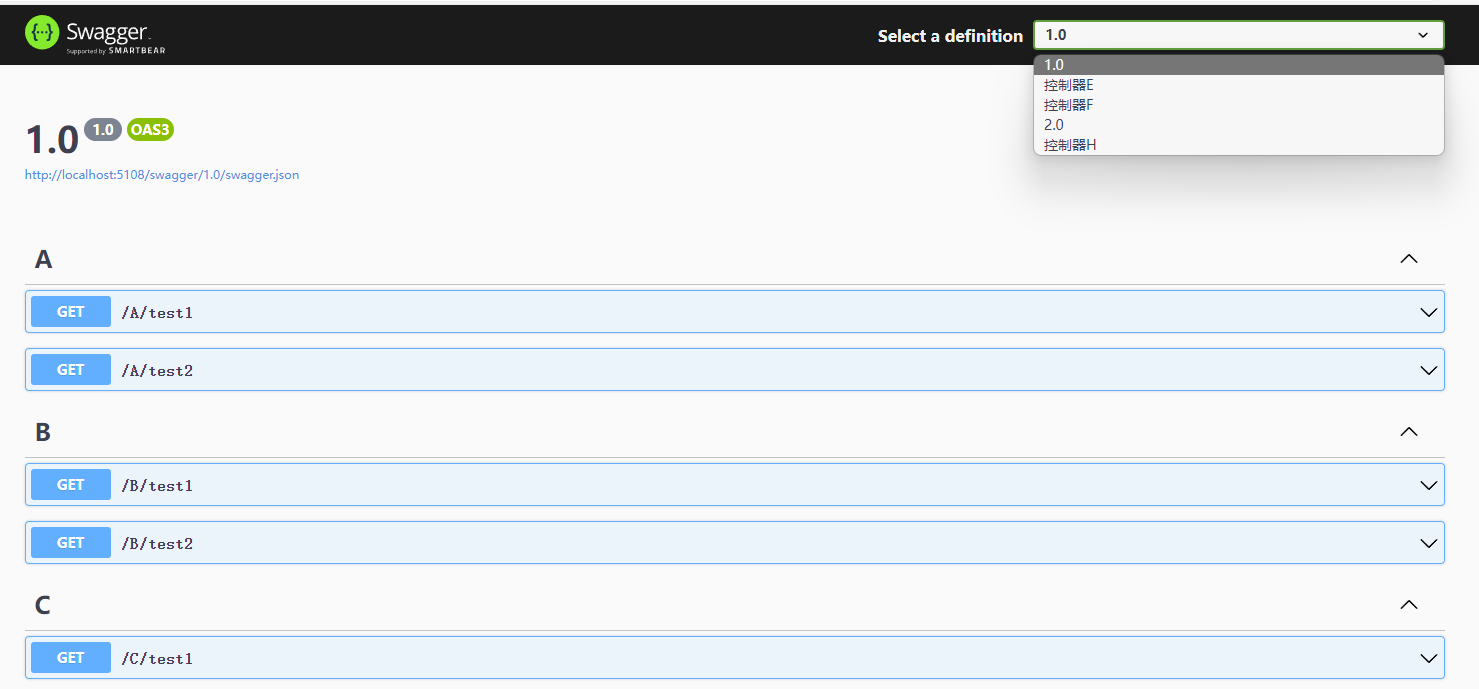
路由后缀
在微服务场景下,许多服务会共用一个域名,然后使用不同的路由后缀指向对应的服务,比如 https://localhost/a、 https://localhost/b ,不过默认 swagger ui 中请求时,使用了绝对路径,因此不会自动使用这些路由后缀参数。为了能够让 swagger ui 在微服务下能够支持不同路由后缀请求,需要对此进行配置。
// 2,这里配置中间件
app.UseMaomiSwagger(setupAction: setup =>
{
setup.PreSerializeFilters.Add((swagger, httpReq) =>
{
swagger.Servers = new List<OpenApiServer>
{
new (){ Url = $"{httpReq.Scheme}://{httpReq.Host.Value}/mya" },
new (){ Url = $"{httpReq.Scheme}://{httpReq.Host.Value}/myb" }
};
});
});
